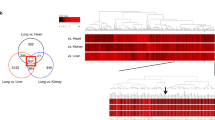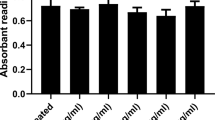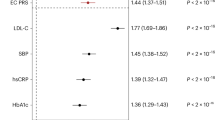Abstract
Benidipine is a dihydropyridine-Ca2+ channel blocker used in the treatment of hypertension and angina pectoris. In the present study, we examined the effects of benidipine on the endothelial differentiation of circulating endothelial progenitor cells (EPCs) using an in vitro culture method. Peripheral blood derived mononuclear cells (PBMCs) containing EPCs were isolated from C57BL/6 mice, and then the cells were cultured on vitronectin/gelatin-coated slide glasses. After 7 days of culture, endothelial cells differentiated from EPCs were identified as adherent cells with 1,1′-dioctadecyl-3,3,3′,3′-tetramethyl-indocarbocyanine–labeled acetylated low density lipoprotein (DiI-Ac-LDL) uptake and lectin binding under a fluorescent microscope. Incubation of PBMCs for 7 days with benidipine (0.01–1 μmol/l) significantly increased the number of DiI-Ac-LDL+/fluorescein isothiocyanate-lectin (FITC-Lectin)+ cells. Wortmannin, a phosphoinositide-3 kinase (PI3K) inhibitor, selectively attenuated the effect of benidipine on the endothelial differentiation. In addition, benidipine treatment augmented the phosphorylation of Akt, indicating that the PI3K/Akt pathway contributed, at least in part, to the endothelial differentiation induced by benidipine. These results suggest that the treatment with benidipine may increase the endothelial differentiation of circulating EPCs and contribute to endothelial protection, prevention of cardiovascular disease, and/or an improvement of the prognosis after ischemic damage.
Similar content being viewed by others
Article PDF
References
Isner JM, Asahara T : Angiogenesis and vasculogenesis as therapeutic strategies for postnatal neovascularization. J Clin Invest 1999; 103: 1231–1236.
Asahara T, Murohara T, Sullivan A, et al: Isolation of putative progenitor endothelial cells for angiogenesis. Science 1997; 275: 964–967.
Takahashi T, Kalka C, Masuda H, et al: Ischemia- and cytokine-induced mobilization of bone marrow–derived endothelial progenitor cells for neovascularization. Nat Med 1999; 5: 434–438.
Hill JM, Zalos G, Halcox JP, et al: Circulating endothelial progenitor cells, vascular function, and cardiovascular risk. N Engl J Med 2003; 348: 593–600.
Quyyumi AA, Hill JM : Circulating endothelial progenitor cells as novel biological determinants of vascular function and risk. Can J Cardiol 2004; 20: 44B–48B.
Gill M, Dias S, Hattori K, et al: Vascular trauma induces rapid but transient mobilization of VEGFR2(+)AC133(+) endothelial precursor cells. Circ Res 2001; 88: 167–174.
Shintani S, Murohara T, Ikeda H, et al: Mobilization of endothelial progenitor cells in patients with acute myocardial infarction. Circulation 2001; 103: 2776–2779.
Kawamoto A, Gwon HC, Iwaguro H, et al: Therapeutic potential of ex vivo expanded endothelial progenitor cells for myocardial ischemia. Circulation 2001; 103: 634–637.
Kocher AA, Schuster MD, Szabolcs MJ, et al: Neovascularization of ischemic myocardium by human bone-marrow–derived angioblasts prevents cardiomyocyte apoptosis, reduces remodeling and improves cardiac function. Nat Med 2001; 7: 430–436.
Kitakaze M, Karasawa A, Kobayashi H, Tanaka H, Kuzuya T, Hori M : Benidipine: a new Ca2+ channel blocker with a cardioprotective effect. Cardiovasc Drug Rev 1999; 17: 1–15.
Yasunari K, Maeda K, Nakamura M, Watanabe T, Yoshikawa J : Benidipine, a long-acting calcium channel blocker, inhibits oxidative stress in polymorphonuclear cells in patients with essential hypertension. Hypertens Res 2005; 28: 107–112.
Kita T, Suzuki Y, Eto T, Kitamura K : Long-term anti-hypertensive therapy with benidipine improves arterial stiffness over blood pressure lowering. Hypertens Res 2005; 28: 959–964.
Ito A, Fukumoto Y, Shimokawa H : Changing characteristics of patients with vasospastic angina in the era of new calcium channel blockers. J Cardiovasc Pharmacol 2004; 44: 480–485.
Yao K, Sato H, Sonoda R, et al: Effects of benidipine and candesartan on kidney and vascular function in hypertensive Dahl rats. Hypertens Res 2003; 26: 569–576.
Dohi Y, Kojima M, Sato K : Benidipine improves endothelial function in renal resistance arteries of hypertensive rats. Hypertension 1996; 28: 58–63.
Karasawa A, Rochester JA, Ma XL, Lefer AM : Protection of endothelial damage and systemic shock by benidipine, a calcium antagonist, in rats subjected to splanchnic ischemia and reperfusion. Circ Shock 1991; 33: 135–141.
Yao K, Karasawa A : Protective effects of benidipine against myocardial damage following ischemia and reperfusion in the isolated perfused rat heart. Biol Pharm Bull 1994; 17: 517–521.
Sato H, Karasawa A, Kubo K : Protective effect of benidipine on rat endothelial injury induced by sodium citrate. Clin Report 1992; 26: 4397–4404.
Higo K, Karasawa A, Kubo K : Protective effects of benidipine hydrochloride (KW-3049), a calcium antagonist, against experimental arterial calcinosis and endothelial dysfunction in rats. J Pharmacobiodyn 1992; 15: 113–120.
Kobayashi N, Kobayashi K, Hara K, et al: Benidipine stimulates nitric oxide synthase and improves coronary circulation in hypertensive rats. Am J Hypertens 1999; 12: 483–491.
Asanuma H, Kitakaze M, Node K, et al: Benidipine, a long-acting Ca channel blocker, limits infarct size via bradykinin- and NO-dependent mechanisms in canine hearts. Cardiovasc Drugs Ther 2001; 15: 225–231.
Matsubara M, Yao K, Hasegawa K : Benidipine, a dihydropyridine-calcium channel blocker, inhibits lysophosphatidylcholine-induced endothelial injury via stimulation of nitric oxide release. Pharmacol Res 2006; 53: 35–43.
Yao K, Ina Y, Sonoda R, Nagashima K, Ohmori K, Ohno T : Protective effects of benidipine on hydrogen peroxide–induced injury in rat isolated hearts. J Pharm Pharmacol 2003; 55: 109–114.
Mason RP, Marche P, Hintze TH : Novel vascular biology of third-generation L-type calcium channel antagonists: ancillary actions of amlodipine. Arterioscler Thromb Vasc Biol 2003; 23: 2155–2163.
On YK, Kim CH, Oh BH, Lee MM, Park YB : Effects of angiotensin converting enzyme inhibitor and calcium antagonist on endothelial function in patients with essential hypertension. Hypertens Res 2002; 25: 365–371.
Berkels R, Taubert D, Bartels H, Breitenbach T, Klaus W, Roesen R : Amlodipine increases endothelial nitric oxide by dual mechanisms. Pharmacology 2004; 70: 39–45.
Miura S, Fujino M, Matsuo Y, Tanigawa H, Saku K : Nifedipine-induced vascular endothelial growth factor secretion from coronary smooth muscle cells promotes endothelial tube formation via the kinase insert ___domain-containing receptor/fetal liver kinase-1/NO pathway. Hypertens Res 2005; 28: 147–153.
Lai YM, Fukuda N, Su JZ, et al: Novel mechanisms of the antiproliferative effects of amlodipine in vascular smooth muscle cells from spontaneously hypertensive rats. Hypertens Res 2002; 25: 109–115.
Umemoto S, Tanaka M, Kawahara S, et al: Calcium antagonist reduces oxidative stress by upregulating Cu/Zn superoxide dismutase in stroke-prone spontaneously hypertensive rats. Hypertens Res 2004; 27: 877–885.
Toba H, Nakagawa Y, Miki S, et al: Calcium channel blockades exhibit anti-inflammatory and antioxidative effects by augmentation of endothelial nitric oxide synthase and the inhibition of angiotensin converting enzyme in the NG-nitro-L-arginine methyl ester–induced hypertensive rat aorta: vasoprotective effects beyond the blood pressure–lowering effects of amlodipine and manidipine. Hypertens Res 2005; 28: 689–700.
Dimmeler S, Aicher A, Vasa M, et al: HMG-CoA reductase inhibitors (statins) increase endothelial progenitor cells via the PI3-kinase/Akt pathway. J Clin Invest 2001; 108: 391–397.
Asahara T, Takahashi T, Masuda H, et al: VEGF contributes to postnatal neovascularization by mobilizing bone marrow–derived endothelial progenitor cells. EMBO J 1999; 18: 3964–3972.
Umemoto S, Kawahara S, Hashimoto R, et al: Different effects of amlodipine and enalapril on the mitogen-activated protein kinase/extracellular signal-regulated kinase kinase–extracellular signal-regulated kinase pathway for induction of vascular smooth muscle cell differentiation in vivo. Hypertens Res 2006; 29: 179–186.
Loomans CJ, Dao HH, van Zonneveld AJ, Rabelink TJ : Is endothelial progenitor cell dysfunction involved in altered angiogenic processes in patients with hypertension? Curr Hypertens Rep 2004; 6: 51–54.
Aicher A, Heeschen C, Mildner-Rihm C, et al: Essential role of endothelial nitric oxide synthase for mobilization of stem and progenitor cells. Nat Med 2003; 9: 1370–1376.
Duda DG, Fukumura D, Jain RK : Role of eNOS in neovascularization: NO for endothelial progenitor cells. Trends Mol Med 2004; 10: 143–145.
Ma FX, Han ZC : Statins, nitric oxide and neovascularization. Cardiovasc Drug Rev 2005; 23: 281–292.
Shiojima I, Walsh K : Role of Akt signaling in vascular homeostasis and angiogenesis. Circ Res 2002; 90: 1243–1250.
Author information
Authors and Affiliations
Corresponding author
Rights and permissions
About this article
Cite this article
Ando, H., Nakanishi, K., Shibata, M. et al. Benidipine, a Dihydropyridine-Ca2+ Channel Blocker, Increases the Endothelial Differentiation of Endothelial Progenitor Cells In Vitro. Hypertens Res 29, 1047–1054 (2006). https://doi.org/10.1291/hypres.29.1047
Received:
Accepted:
Issue Date:
DOI: https://doi.org/10.1291/hypres.29.1047
Keywords
This article is cited by
-
Stimulation of endothelial progenitor cells: a new putative effect of several cardiovascular drugs
European Journal of Clinical Pharmacology (2010)
-
Circulating endothelial progenitor cells in Chinese patients with acute stroke
Hypertension Research (2009)
-
Calcium-Dependent and Endothelium-Dependent Mechanisms for a Constrictor Response of the Saphenous Vein
Bulletin of Experimental Biology and Medicine (2009)



